Mountain roads in the Himalayas are notoriously treacherous, claiming numerous deaths every year. Road casualties are often due to inadequate road construction, which can cause landslides, rock fall and avalanches. In fact, research from around the Himalayas has shown that around 30 to 40 percent of all landslides may be due to road construction, compounded by more extreme rainfall events.
In areas affected by seasonal monsoon rains, roads may be closed for days, sometimes weeks, causing difficulties for school children who may be forced to cross dangerous landslide-prone areas or take long detours to reach school. In Nepal, the policy is to connect all villages in the Middle Hills and Mountain areas within two hours walking distance of a road. In the Terai plains, the goal is to cut this down to one hour. It is therefore not unusual for young children to walk up to four hours to go to school and come back.
To commemorate International Mountain Day, here’s a few examples of how nature-based solutions can improve the safety of youth in mountain regions. Eco-safe roads promote the use of deep-rooted grasses and shrubs, which help to stabilize soil on steep slopes above and below roads. This is often done in combination with engineered solutions such as gabion walls or drainage structures. Engineering structures may be strong as soon as the concrete has dried, but over time they require more maintenance and reinforcement, or replacement. Hybrid combinations are often the most cost-effective: the hard engineering structures provide stability while the plants take root. Then, after the initial plantation of seedlings, watering and weeding, vegetation can be strong enough to maintain roadside slopes, effectively protecting it against erosion and landslides.
“Eco-safe roads are nature-based solutions which can increase local resilience by mitigating hazards, such as landslides, as well as by supporting and protecting livelihoods. There is significant opportunity in further scaling up such approaches across mountain landscapes to achieve both sustainable and resilient development,” said Marisol Estrella, Programme Coordinator at UNEP’s Disaster Risk Reduction, Crisis Management Branch.
Mountain roads can be seen as double-edged swords. Good roads are indeed needed to facilitate mobility and enable mountain youth to access education, employment and markets, but bad roads destroy fields and increase the risk of landslides.
Results from pilot demonstrations with low-tech eco-safe roads are positive. With little investment, roads stay open longer during the monsoon season and communities reap additional livelihood benefits from the grasses, such as fodder and brooms. Safe roads thus make it easier for young people to be mobile and find employment.
Mountain regions occupy about one-quarter of the Earth’s land surface and are home to 15 percent of the world’s population. In 2002, the UN General Assembly declared 2002 the UN International Year of Mountains and then designated 11 December, from 2003 onwards, as International Mountain Day.
Original source: UN Environment
Published on 10 December 2019

